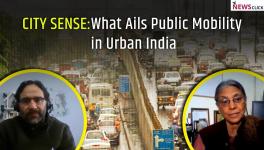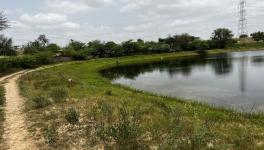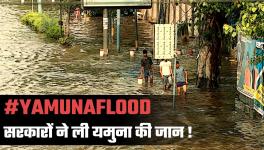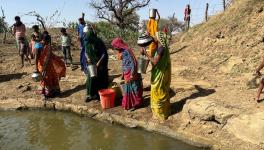Draft National Water Policy 2012: no clarity or hidden agenda?
The Draft National Water Policy 2012 (DNWP 2012) released by the government earlier this year sought to “take cognizance of the existing situation and to propose a framework for creation of an overarching system of laws and institutions and for a plan of action with a unified national perspective” to deal with water as a “natural resource, fundamental to life, livelihood, food security and sustainable development.”
If this was indeed a sincere goal, then DNWP 2012 has failed miserably. Given the near-crisis water scenario in the country, this is a major problem indeed, for this means that the nation is far away from a badly needed new policy direction on water resources.
The Ministry of Water Resources gave only a brief one-month period till end February for the public to give feedback. Even if this process of inviting public comments were to be taken seriously, which is unlikely given the cavalier way in which previous such exercises have been conducted with government either ignoring comments received or cherry-picking suggestions to suit pre-conceived designs, this was clearly insufficient time to obtain informed comments or suggestions from concerned citizens and organizations. In addition, conducting only four regional consultations with Panchayat Raj Institutions will not even begin to capture the diversity of opinion on this important subject, nor the range of water-related issues facing inhabitants of rural and urban settlements and other water users across the country.
Typical of such policy documents put out by the government in recent years, there is n attempt to describe many of the major problems, at least to the extent that critics are not able to point to glaring omissions. But in the Draft Water Policy, several very important issues are in fact not covered or glossed over, and the discussion as regards what needs to be done is often poor, offering sometimes quite vague solutions and even ignoring many well-known perspectives put forward since long by experts. At the same time, amidst much vagueness and many mutually contrary conclusions, the Draft Policy strongly puts forward a few new ideas, in particular the dangerous notion that water should be treated as an economic good and, consequently, that pricing of water could be a major instrument for regulating its use.
Unsurprisingly, NDWP2012 has been sharply criticized by many experts and concerned organizations, leaving open to debate many important issues confronting people of this country with regard to water. Salient aspects of this Policy document are examined in this article.
Impending availability crisis To begin with, DNWP 2012 does not come near to recognizing the depth of the looming water crisis which will only get exacerbated by climate change. While noting that India is a water-scarce region, with only 4 percent of the world’s fresh water resources for over 17 percent of global population, the document evades the significant and frightening reality that per capita availability of water in India has reduced to about 33 percent of the level obtaining at independence. India is already at a cusp. It is estimated that by 2020, demand for water will exceed all sources of supply. Many leading experts, UN organizations and other agencies have warned that by 2050, per capita availability will shrink from roughly 1700 cubic metres annually, a level classified as “water stressed,” to under 1000 cubic metres, below WHO’s “water scarce” level. If DNWP 2012 had confronted this harsh reality, its many conclusions and policy recommendations would not have been so lame.
Thus even while acknowledging that, given obvious limitations in enlarging water availability, demand management would have to be a key aspects of future planning, DNWP 2012 does not offer major new perspectives or significant measures for achieving this. The document only puts forward, rather casually, some ideas such as shifting to drip irrigation and local storage in farm ponds.
But there is no discussion of how to bring about significant reductions in the current pattern of high over-irrigation, or of the need to reverse the continuous push to bringing new areas under irrigation, including the repeated exhortations by the government and the Prime Minister himself to bring about a “second green revolution,” with all its connotations of water-intensive and inorganic chemical intensive agriculture. The increasing reliance on groundwater for irrigation as well as for domestic and industrial use, and the mounting over-extraction of groundwater far exceeding recharge rates, has resulted in growing water stress in large parts of the country, calling for a complete overhaul of regulatory systems and enforcement mechanisms in the country.
Similarly there is passing reference to watershed management projects, rainwater harvesting, steps to minimize run-off and promote recharge of aquifers, but little discussion of measures and systematic programmes to achieve these ends. One cannot be blamed for reading the document’s suggestions as just pious posturing when, under the nose of the central government in the capital city, the recharge system in the Yamuna river bed is being actively undermined by construction activities by government agencies in blatant violation of rules and stated policy, such as in the Akshardham temple, the Commonwealth Games complex and various Metro Rail and bus depots.
Pollution The problem of water availability is of course compounded by the poor quality of water, especially for potable uses. DNWP 2012 acknowledges the problem but does not come remotely close to recognizing its severity and consequently offers, once again, what should be considered extremely naïve remediation measures if they are not to be regarded simply as posturing. Noting that “growing pollution of water sources is affecting the availability of safe water besides causing environmental and health hazards,” the draft Policy proposes that pollution of water bodies “should not be allowed” and, through a “system of third party periodic inspection,” “heavy penalty should be imposed based on polluter pays principle.” Even if ultimately solutions will require co-evolution of appropriate legal frameworks, regulatory systems and institutional structures, surely a draft Policy document could at least indicate possible instrumentalities that could address the problem given known lacunae in these areas.
But there is no discussion of the emasculation of Pollution Control Boards and the absence of enforcement powers in bodies such as the Central Groundwater Board. It is also widely known that the State itself, that is, governments at central, state and municipal level, as well as Industrial Development Corporations, are often structurally complicit with industries and corporate bodies in turning a blind eye to blatant discharge of untreated effluents or, even worse, not putting in place treatment measures. Indeed, in many cases, the State itself is the culprit. Many industrial estates have come up and continue to be supported, for example in Gujarat and Tamil Nadu, without adequate effluent treatment or disposal systems, ignoring outcries by local residents and citizens organizations. Even in the pampered national capital, almost half the sewage is discharged untreated into the Yamuna which has therefore become more drain than river. And governments at all levels have watched silently as toxic chemicals dumped at the notorious Union Carbide plant have continuously leached into groundwater in Bhopal for over two decades! Fines? Heavy penalty? Polluter pays? How is this nirvana expected to be reached?
Without any reflections on these questions, the document only makes yet another bald statement that all levels of government must “ensure access to a minimum quantity of potable water… available within easy reach of the household.” What should be the standard for “minimum quantity” of potable water? Can water distribution systems make clear distinctions between potable water and treated yet below potable standards water? Or should one speak of minimum quantity of treated water which covers water for drinking and other essential household purposes, as normatively laid down by WHO and other agencies? And what should be the standards of potability? Does water treated and supplied by municipal agencies today, even in the capital or other metros, meet international standards, and if not why is this so and what needs to be done to improve it? Why is it that in most developed countries, citizens feel safe in drinking water from the tap, but in India all middle-class households who can afford it feel compelled to buy and install expensive water purification systems? Is not sub-standard “potable” water a major reason for the burgeoning bottled water industry? All these are no doubt tough questions but sweeping them under the carpet can only mean that a national water policy will remain that in name only.
Right to water Perhaps a large part of why DNWP 2012 does not think through these difficult issues is because it is torn between viewing water as a public good, with water-related services therefore being a public service, and regarding water as an economic good whose supply and regulation are to be governed largely through fiscal measures. In the balance, DNWP leans toward the latter approach while paying lip service to the former as a desirable principle but unable to work out how and where to draw the line.
The Draft Policy Water states that water is a “natural resource, fundamental to life, livelihood, food security and sustainable development,” should therefore be regarded as “a community resource held, by the state, under public trust doctrine.” The document adds that ” since “water is essential for sustenance of the ecosystem,” “ecological needs [must be] given due consideration,” which understates the centrality of sustainability in considering water use. DNWP 2012 therefore suggests that the “principle of equity and social justice must inform use and allocation of water.”
At the same time it argues that, “Water, over and above the pre-emptive need for safe drinking water and sanitation, should be treated as an economic good so as to promote its conservation and efficient use.” While DNWP 2012 does suggest that, within this framework, “higher priority [be accorded] towards basic livelihood support to the poor and ensuring national food security,” there is heavy emphasis on pricing and related incentives, as also a few penalties. The Document recommends a new tariff system at river basin, sub-basin and state levels, as well as “water charges reflect[ing] the full recovery of the cost of administration, operation and maintenance.” It also recommends incentives, subsidies and tariff adjustment to regulate water use, reuse and recycling, clearly preferring this to administrative and legal regulatory systems.
In fact, experience the world over has suggested that, while tariffs and systems of incentives and disincentives are useful at the margins especially for industrial and commercial users, strict regulation, monitoring and ensuring compliance including through substantial penalties are the major means through which countries can regulate water use and promote efficiencies and sustainability.
It is therefore difficult to understand the conclusion of DNWP 2012 that “the Service Provider role of the state has to be gradually shifted to that of a regulator of services and facilitator for strengthening the institutions responsible for planning, implementation and management of water resources [and that] water related services should be transferred to community and/or private sector with appropriate ‘Public Private Partnership’ model.” One is left wondering how the provisioning of water as a public good essential for life would be facilitated by such a policy.
There is some useful discussion in DNWP 2012 on legal and regulatory systems. A national Water Framework Law is proposed such as to provide an overarching recognition of principles and frameworks governing water issues guided by which each State would be able to enact appropriate legislation, set up regulatory systems and adopt necessary administrative mechanisms to regulate water use. Mention has also been made of amending the Indian Easements Act 1882 which seems to bestow rights to land owners or their lessees over underground water below these lands. DNWP 2012 also speaks of the need for State Water Regulatory Authorities, water users associations and other institutional arrangements down to municipal and other local levels, as also a guiding principle of treating the river basin as the basis for all water resource planning. Discussion on some of these could doubtless be useful, provided there is greater clarity on the overall goal, approach and perspective. Such discussion should also account for, as DNWP 2012 does not, current approaches and practices, and what these, rather than some pious intentions in documents, convey about prevalent thinking on water governance. For instance, there is a major push to directly or indirectly privatise water utilities and related services, there is little or no regulation of groundwater extraction especially for industrial and commercial purposes, and there is active undermining of municipal autonomy and local arrangements in favour of dominant centralised models under the guise of reforms. Unfortunately, DNWP 2012 has not taken such a comprehensive approach and, consequently, raises far more question than it answers.
Get the latest reports & analysis with people's perspective on Protests, movements & deep analytical videos, discussions of the current affairs in your Telegram app. Subscribe to NewsClick's Telegram channel & get Real-Time updates on stories, as they get published on our website.
























